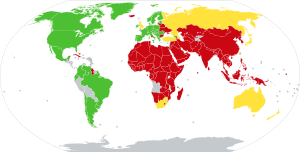Ponografia
Ponografia (kutoka neno la Kigiriki cha kisasa πορνογραφία, pornografia, ambalo linaunganisha πόρνη, pornē, yaani "kahaba" au πορνεία, porneia, yaani "ukahaba"[1]), na γράφειν, grafein, "kuandika, kutunza kumbukumbu, hata mchoro", na kumalizika ns ία, ia, yaani "hali ya, mali ya, mahali pa") ni picha au maandishi yenye lengo la kuwatia ashiki watazamaji au wasomaji.


Katika utandawazi ponografia inatumia njia zote za mawasiliano na kuenea katika kila pembe ya dunia, ikiathiri hasa vijana na watoto na kuchangia ubakaji na matatizo mengine[2].
Ndiyo sababu katika nchi mbalimbali kuna sheria ambazo zinaidhibiti au kuikataza na kuiadhibu kabisa, hasa inapohusisha watoto.
Pamoja na sheria, upinzani unatokana na wanaopigania haki za wanawake[3][4][5][6][7][8] na wanaofuata dini.[9][10]
Kwa mfano, Kanisa Katoliki linakataza ponografia tangu Karne za Kati, na katika Katekisimu yake rasmi ya sasa inaipinga tena katika n. 2354[11]
Ingawa ponografia ina madhara kwa afya ya nafsi [12], ni vigumu kuizuia kwa kuwa inagusa silika ya watu na ni biashara kubwa kabisa inayolenga pesa, si maendeleo ya jamii, na kudhalilisha binadamu. Huko Marekani tu inazungusha dola bilioni 2.5 kwa mwaka.
Tanbihi
hariri- ↑ List of Greek words starting with πορν- (porn-) on Perseus.
- ↑ https://www.mwananchi.co.tz/mw/habari/kitaifa/picha-video-za-ngono-zinavyochangia-kupunguza-hamu-ya-tendo-la-ndoa-3905372
- ↑ Shrage, Laurie. (2007-07-13). "Feminist Perspectives on Sex Markets: Pornography". In: Stanford Encyclopedia of Philosophy.
- ↑ Mackinnon, Catherine A. (1984) "Not a moral issue". Yale Law and Policy Review 2:321–345. Reprinted in: Mackinnon (1989). Toward a Feminist Theory of the State Harvard University Press. ISBN 0-674-89645-9 (1st ed), ISBN 0-674-89646-7 (2nd ed). "Sex forced on real women so that it can be sold at a profit to be forced on other real women; women's bodies trussed and maimed and raped and made into things to be hurt and obtained and accessed, and this presented as the nature of women; the coercion that is visible and the coercion that has become invisible—this and more grounds the feminist concern with pornography".
- ↑ "A Conversation With Catherine MacKinnon (transcript)". Think Tank (PBS). 1995. http://www.pbs.org/thinktank/transcript215.html. Retrieved 1 September 2009.
- ↑ MacKinnon, Catharine (1987). Feminism Unmodified: Discourses on Life and Law Cambridge, MA: Harvard University Press. p. 147.
- ↑ "2 male porn performers test positive for HIV". Retrieved on 31 December 2014.
- ↑ Jeffries, Stuart. "Stuart Jeffries talks to leading feminist Catharine MacKinnon", The Guardian, 12 April 2006.
- ↑ Sherkat and Ellison, 1997, "The Cognitive Structure of a Moral Crusade", Social Forces 75(3), p. 958.
- ↑ Sherkat and Ellison, 1999, "Recent Developments and Current Controversies in the Sociology of Religion" Archived 4 Machi 2016 at the Wayback Machine., Annual Review of Sociology 25, p. 370.
- ↑ Pornography consists in removing real or simulated sexual acts from the intimacy of the partners, in order to display them deliberately to third parties. It offends against chastity because it perverts the conjugal act, the intimate giving of spouses to each other. It does grave injury to the dignity of its participants (actors, vendors, the public), since each one becomes an object of base pleasure and illicit profit for others. It immerses all who are involved in the illusion of a fantasy world. It is a grave offense. Civil authorities should prevent the production and distribution of pornographic materials.
- ↑ https://www.lifesitenews.com/news/catholic-university-study-finds-strong-link-between-porn-use-and-depression-anxiety-in-students/?inf_contact_key=e88aef8df22201feed3275621e75a626b7af0999dac2af6212784c39e05d2aef
Viungo vya nje
hariri| Makala bado ni mbegu. Unaweza kuisaidia Wikipedia kwa kuongezea habari. |